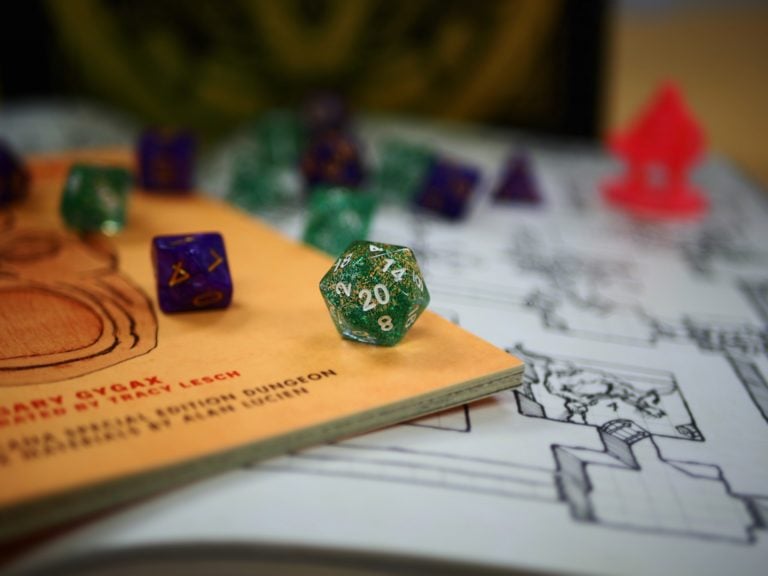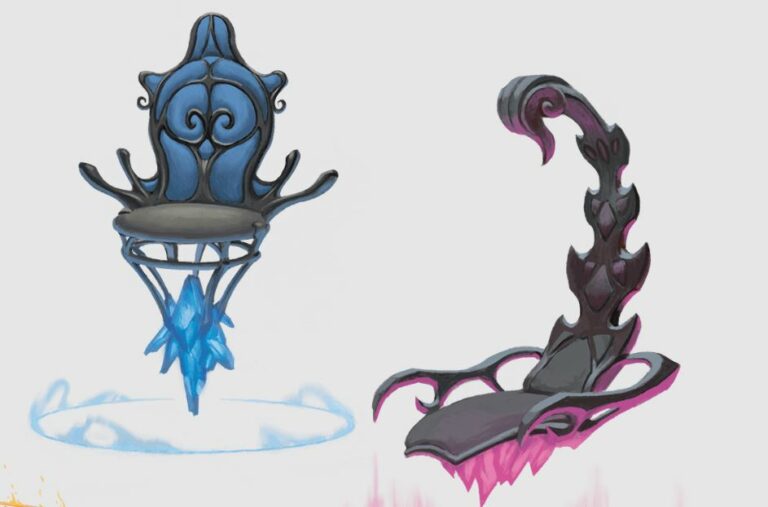Hexblood 5E Lineage Guide | Play as a Hag
Your soul has been stitched together by blood and magic. Ancient magic has entered your life, and your body, and has changed you forever. Your body has been changed, making you vastly different from the others of your race. You may have made a deal with a hag, or simply was in the wrong place at the wrong time. No matter what, this lineage from Van Richten’s Guide to Ravenloft will permanently change your life. Will you let your Hexblood Lineage 5E define you, or will you mold your innate magic to your advantage?

Table of Contents
Hexblood 5E Lineage Guide
Hexbloods are typically born of Hags, who use a ritual to create more of themselves. However, the Hexblood can also spawn from fey kidnappers or a natural curse. No matter what, the spirits of nature have damned you in some way, and you are now cursed to hold this ancient magic within you. You have rune-etched skin, often colored differently than the standard skin colors of your race. You might sprout horns or other easily identifiable hag features, like claws.
As a hexblood, you are far from alone, however. You might be part of the Hazlan, Kartakass, or Tempest Domains of Dread. These organizations are centered around supernatural forces, and witches are commonly welcomed there. Talk to your DM to make sure these organizations make sense for your campaign.
What is a Lineage in 5E?

A Lineage is essentially a template that goes on top of an already established race. So, you can be a Hexblood, or you can be a Dwarf Hexblood, or an Elf Hexblood. The Lineage takes most of the features of that race away, so it really only matters in flavor… But there are some aspects of your race that stick around, so keep it in mind as you build a Lineage character! All Lineage characters gain a few specific benefits.
No matter what your base race was, you may now choose new Racial Ability Scores. These are a +2 in one score and a +1 in another. Alternatively, you may choose +1 in three different scores. You can choose whatever you like, which makes character building much easier.
You may learn Common and one other language, unless you’d rather use your base race’s languages. So, a Dwarf Hexblood might have Common and Dwarven. But, their exposure to the Feywild might make them learn Common and Sylvan instead. This is a conversation that you should have with your DM, since it changes a bit of your backstory.
Finally, some Lineages change your Creature Type. A Hexblood is a Fey, and that means that they are considered a Fey for spells and effects. You cannot be affected by Hold Person, but you could be affected by an Anti-Fey spell, such as the Oath of the Ancients Paladin using Turn the Faithless. Your type changes no matter what your base race was.
How Does Hexblood Lineage Work?
The Hexblood replaces most of the racial traits of your Class with the following list of traits.
- Fey Creature Type.
- Medium or Small Size. This isn’t necessarily based on your race; maybe your Hexblood nature caused your Goliath to shrink to half the size. However, it might be best to make it make sense for your race.
- 30 ft Speed. This is just the standard movement speed. That’s obviously good, but far from the reason to join a Hag coven!
- Ancestral Legacy. At minimum, you get two skills of your choice. That’s fantastic! However, if you can combine the Legacy with a Movement Speed type and extra skills… That’s where you get some value! If you want to optimize this lineage, consider an Aarakocra, Lizardfolk, or Tabaxi; those races have great movement speed options, and in the case of Lizardfolk and Tabaxi, they get 2 skills on top of the speed!
- Darkvision. Great. Give the torch to someone who has trouble seeing. You get to see in the dark, which can be good for finding treasure or finding evil threats.
- Eerie Token. Super neat mechanic, but it doesn’t do anything by itself.
- Telepathic Message. You get telepathy with an absolutely massive distance. That’s awesome, but they don’t get to send a message back. That can only be so handy, but it can keep you from being screwed by getting kidnapped or separated from the rest of the party. And you can split the party and still send some information back and forth.
- Remote Viewing. You can see through your token. That’s fine, especially if you can sneak your token into the pocket of an unsuspecting criminal or cultist. Then, you can use your sight to try and look around, perhaps catching the criminal in the act. However, this can only happen once per rest. Hope you reverse-pickpocketed the right guy!
- Hex Magic. Disguise Self is situational, but very fun for when it comes in handy. The more creative you are, the better it is. Hex is much more useful in general, allowing you to deal 1d6 damage on each attack you make against someone. If you’re playing a Monk or a Fighter, then this can do a ton of damage to a high-priority target!
Is Hexblood Good in 5E?
In general, this is a middling power lineage. Eerie Token is it’s most unique mechanic, and it’s highly situational. If you need to split your party, you’ll be very happy to have this ability. But, without a way to talk back, there’s only so much that Telepathic Message can do to help you. Remote Viewing also suffers from being rather specific, but you can attach it to a Rat or something to help scout ahead without much problem. It has some of the weirdest utility of any race in the game right now… And that’s a good thing!
Because of Hex Magic, Fighter and Monk might be the best class options for the Hexblood. You get out-of-combat utility with your extra skills and weird Eerie Token stuff. Then, you can use Hex to absolutely decimate an enemy in a fight with a d6 extra damage on each attack.
What Do Hexbloods Look Like?
Hexbloods have unique physical traits. While these creatures retain the size and shape of their original race, they adopt certain physical traits that set them apart. These changes include ears that split in forked points, skin in lurid shades, long hair that regrows if cut, and an irremovable living crown. This crown, which is commonly referred to as an eldercross or a witch’s turn, is a living, garland-like part of a hexblood’s body extends from their temples and wraps behind the head.
What Are Common Hexblood Names?
Unlike some races or lineages, hexbloods do not have a traditional naming system. This is because a hexblood was not always hag-affiliated. Hexbloods come from a wide range of races, and they generally retain the name they had in their prior life. A dwarven hexblood might have a traditional dwarven name, while a goblin hexblood could have a goblin name.
It is possible that your hexblood character could take a name of their choosing after crossing paths with the hag that changed their life forever. These names might follow the traditional naming patterns of hags themselves. Common hag names include a formal title, first name, and last name. These titles could include names like Auntie, Granny, Old, or Cackling. There are few limitations when it comes to choosing a name for your hexblood.
How Do Hexbloods Become Hags?
It is possible for a hexblood to irreversibly transform into a hag. This process involves a ritual performed by the hag that created a hexblood. A hexblood could be transformed into the type of hag that their creator represents. Alternatively, a hexblood could become a hag that fits with their nature.
The process for becoming a hag is lengthy. It involves a ritual that the hexblood must consent to for it to be successful. The hexblood becomes a hag forever when it completes the ritual. According to the rules, hexblood characters that go through this ritual will become NPCs unless the DM decides otherwise.
What is the Best Class for Hexblood?
In my opinion, you can make a Hexblood work with any class. This is true in part because of the flexible ability score bonuses that come with the lineage. When you create a custom lineage, you select one ability that gets a +2 bonus and another that gets +1. By assigning these bonuses as you see fit, you can make an optimized build for any class.
That means determining the best class for a hexblood comes down to who will benefit from the lineage’s signature traits. Eerie token is as useful as it is creepy – and it’s quite creepy. You can use it as a simplified sort of scrying or as a telepathic message spell to someone within 10 miles of you. While this is great for a rogue build, most characters could make use of this option.
Where the hexblood really stands out is the Hex Magic trait, given that some classes will get very little out of this at all. The barbarian is arguably the worst option, as they will rarely be in a position where they can cast hex in combat due to rage. Some of the better build options include:
Fighter
The fighter is a great option for a hexblood. this is because the high number of attacks makes the added damage that comes from the hex spell significant. While any fighter subclass could make use of hex, the Eldritch Knight especially benefits from it thanks to the spell slots needed to cast it more than once.
Paladin
Paladin is one of the best options for the hexblood lineage, primarily due to the hex magic trait. Many paladin builds will benefit from hex and the additional damage it offers, while disguise self never hurts. What’s more, paladins have the spell slots available to make continued use of hex throughout an adventure if they choose.
Rogue
No matter your rogue build, you can probably get something useful out of the hexblood lineage. As mentioned above, the Eerie Token trait is great for rogues that act as scouts, as you get a powered-up version of the message spell with a single person. Hex magic is also cool here, as both disguise self and hex are useful spells for most rogue builds.
Hexblood 5E FAQ
Do Hexbloods Need to Sleep?
Unless specified otherwise, a hexblood needs to sleep like any other creature. remember, a hexblood is either a custom lineage or it is based on an existing race. These characters require sleep unless you choose an existing race – like the elf – that does not sleep.
Is Hexblood Undead?
No, a hexblood is not undead. They are considered to be Fey creatures due to the bargain they struck with a hag.
What Race is a Hexblood?
When playing a hexblood, it is possible to meet the in-game requirements of two races. As a hexblood, you are considered to be a Fey creature. That means magic that applies specifically to fey creatures will work on you. However, you also retain your original race as well. If you were a dwarf prior to becoming a hexblood, you will also be considered a dwarf for game mechanics purposes. This means you could use a magical item that only dwarves can use while being affected by a spell that can only target Fey.
Conclusion – Hexblood 5E Guide
The Hexed lineage in 5E is not the strongest lineage, especially compared to the Dhampir. However, it’s weird utility is worth considering. The shenanigans that you can get into with Eerie Token is not to be underestimated. Because of how flexible these Lineages are, we highly suggest trying this out whenever you feel like playing with Eerie Token… And maybe Hex, that’s also a good spell.






